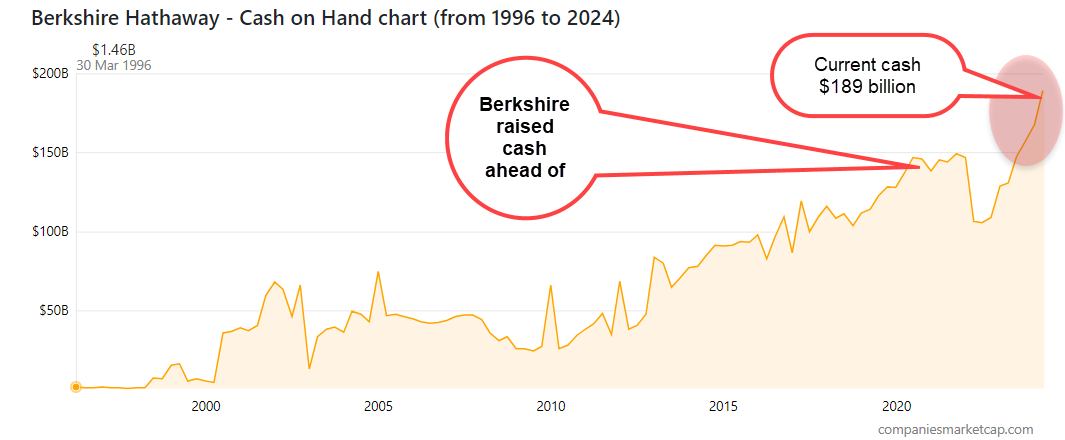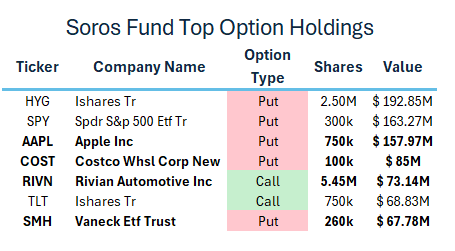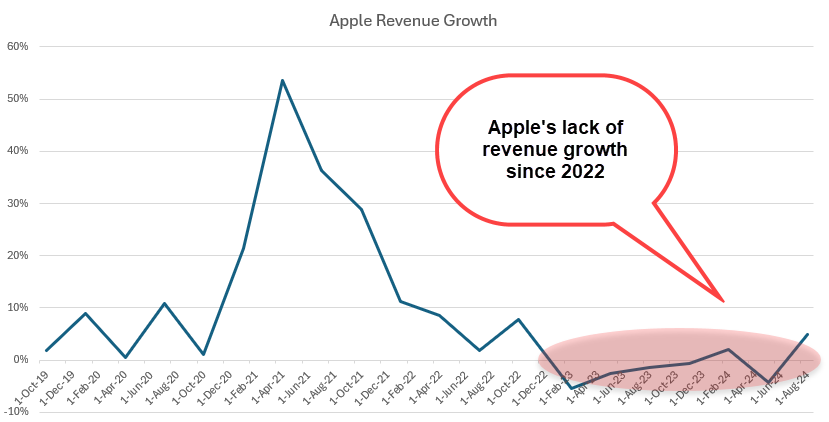Market titans like Warren Buffett, George Soros, and Michael Burry all appear to be making similar moves to protect themselves from what would appear to be a large market correction.
The 13F’s are flying all around Wall Street this week and there are a lot of juicy tidbits in the “Whales” reports for those willing to do a little digging.
We’ll get to a few of the individual stocks that Warren Buffett and George Soros have added to their portfolios another time.
For now, let’s talk about some of the defensive moves that these “Whales” are making ahead of what may be a 20%-plus correction in the S&P 500.
Buffett’s Run on Cash
Most notably, Warren Buffett’s Berkshire Hathaway raised its level of cash to an all-time high of $189 billion over the last quarter.
Historically, there are three reasons that Berkshire Hathaway would be raising cash, but two are standing out right now.
- Opportunity: Buffett will maintain cash on hand to take advantage of opportunities in the market.
- Risk Management: Berkshire has raised cash in the past to protect the fund against a downturn in the market.
- Liquidity Requirements: Like any other fund, Berkshire Hathaway must make sure that they have appropriate levels of cash available to handle any disbursements to clients.
When asked about why Berkshire Hathaway is holding so much cash Buffett responded, “we only swing at pitches we like”.
But things go deeper than that. Buffett May be Looking for a Market Correction
Historically, the S&P 500 experiences a 20%-plus correction about every 18 months or so as a rule. Those healthy corrections offer a chance for market valuations to reset from overvalued status, reviving the reason that investors look to buy stocks.
Buffett has also been very outspoke on his view that the market is overvalued, making it a wise move to hold cash until there are opportunities. That’s his way of telling us that the market needs a reality check.
The last time that Berkshire Hathaway saw record cash holdings was just ahead of the last bear market correction in 2022.
Berkshire’s increased cash holding appears to be a defensive move as the fund is bracing for a larger pullback in equities. That, of course, would generate an opportunity for Berkshire Hathaway to start putting cash to work in the market again, at more reasonable valuations.
George Soros Appears to Be Thinking the Same
George Soros’ Fund appears to be expecting the same market correction as the fund is building what appear to be a hedge for the portfolio.
In the latest 13F from Soros Fund Management, the billionaire hedge fund manager has added to an existing S&P 500 hedge.
Among the portfolios holdings are put options on Apple (AAPL), the High Yield Corporate Bond ETF (HYG), and the S&P 500 ETF (SPY).
The cumulative value of these three put positions amounts to $500 million.
In addition, Soros’ fund just initiated a put position worth a total of $101 million on the VanEck Semiconductor ETF (SMH) and iShares 20 year+ Treasury Bond ETF (TLT).
The last is a big concern. Soros is betting (or hedging) on a bear market move in bonds. That hedge would suggest that the market is going to run into liquidity issues, which always effect other markets.
Let’s bottom line that for you.
Both Soros and Buffett have been cutting back on their long stock holdings to raise cash. George Soros has been going one step further in building a hedge with put options to protect his portfolio from a decline.
The Soros Fund also shares the same sentiment as Berkshire Hathaway on Apple.
Berkshire lowered its Apple holdings by another 49% to 400 million shares. It is rumored that Buffett will likely stay at 400 million shares as this in the same number of shares that he owns in Coke, a stock Buffett has claimed he will never sell.
Soros’ fund recently initiated a short position on Apple with the purchase of $158 million in put options on the iPhone manufacturer.
Both moves may be right on target.
Since 2022, Apple’s revenue growth has remains flat near zero as the company has struggled with renewing the innovation that drove the stock’s success. While Apple is still a dominant force, the company appears to be on the other side of its true growth cycle.
The stock dodged moving into a bear market trend in May 2024 as shares touched their 20-month moving average. From a technical perspective, Apple is not out of the woods yet in terms of long-term performance.
How Can You Hedge a Portfolio Like Soros’ Fund?
Despite the recent rally, the market is still flashing signs that a larger correction is on the horizon.
The recent six day rally pulled stocks from what appeared to be the beginning of a deeper correction, but recent inflation data pulled investors right back into stocks.
All eyes are on the Fed to “save” the market with a series of interest rate cuts, but perhaps not as fast as investors are hoping.
For that reason, being prepared to hedge a portfolio is a wise move.
Consider adding an inverse Exchange Traded Fund (ETF) or a defensive put to your portfolio.
Inverse ETFs are an investment that increase in value as the market goes down.
Read about inverse ETFs here.
For example, the Ultrashort QQQ ETF (QID) goes up roughly 2% for every 1% decline in the Nasdaq 100.
Adding the QID to a portfolio will help to offset losses that you would see from holding large cap technology stocks in your portfolio.
The ETF is an easy addition to a portfolio since you buy it just as you would any stock.
Pro tip: Don’t get too greedy with a hedge like the QID. Set a target price for closing the positions. There’s nothing worse than holding a portfolio hedge too long to have it start losing money.
One Step Further, Use an Option to Protect Your Portfolio
Put options are a great way to protect a portfolio in these conditions, this is how the pros do it.
Put option values increase as the underlying stock or index goes down.
This is a more advanced approach to hedging your portfolio, but its also the most efficient. Think of this approach like you would a term insurance policy. You pay a premium for a put option for a certain time period’s worth of protection. At the end of that time, the protection expires.
Read more about this approach here: https://www.investopedia.com/articles/optioninvestor/07/affordable-hedging.asp
We’ll look for an all-clear signal from the market after the September/August volatility rolls into October when we usually see a strong bottom form in stocks.
Until then, stay safe and hedged.





